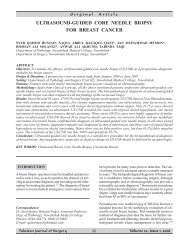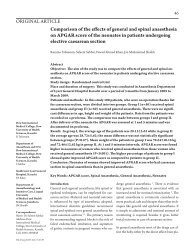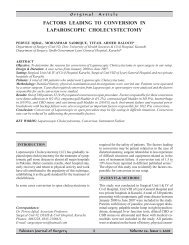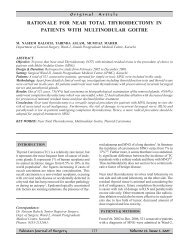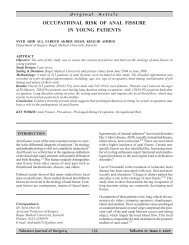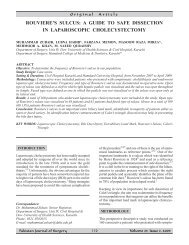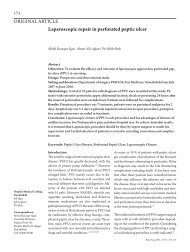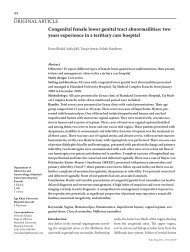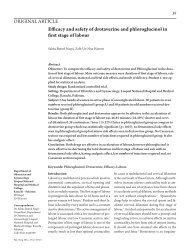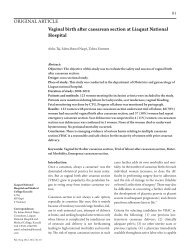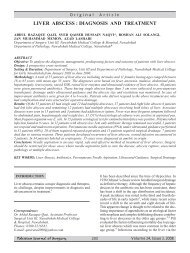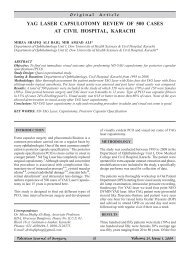Misoprostol for induction of labour at term
Misoprostol for induction of labour at term
Misoprostol for induction of labour at term
Create successful ePaper yourself
Turn your PDF publications into a flip-book with our unique Google optimized e-Paper software.
ORIGINAL ARTICLE<br />
<strong>Misoprostol</strong> <strong>for</strong> <strong>induction</strong> <strong>of</strong> <strong>labour</strong> <strong>at</strong> <strong>term</strong><br />
53<br />
Arshia Javed, Haleema A Hashmi<br />
Abstract:<br />
Objectives: The purpose <strong>of</strong> this study is to assess the effectiveness <strong>of</strong> 50mg vaginal <strong>Misoprostol</strong><br />
<strong>for</strong> <strong>induction</strong> <strong>of</strong> <strong>labour</strong> <strong>at</strong> <strong>term</strong>.<br />
Design: Retrospective observ<strong>at</strong>ional study.<br />
Setting: Department <strong>of</strong> Obstetrics &Gynaecology, Liaqu<strong>at</strong> N<strong>at</strong>ional Hospital, Karachi, Pakistan<br />
from 1st January 2008 to December 2009.<br />
Methods: Two hundred and twenty one p<strong>at</strong>ients were analyzed; who were induced <strong>at</strong> 37<br />
weeks gest<strong>at</strong>ion and onwards by using 50mg vaginal misoprostol repe<strong>at</strong>ed every 6 hourly <strong>for</strong> a<br />
maximum <strong>of</strong> 3 doses or initi<strong>at</strong>ion <strong>of</strong> active <strong>labour</strong>, to assess the efficacy <strong>of</strong> the drug.<br />
Results: The results were analyzed by using SPSS version 13.0. Among 221 p<strong>at</strong>ients 161<br />
(73%) delivered by vaginal route & 60 (27.1%) p<strong>at</strong>ient had caesarean deliveries. Out <strong>of</strong> these<br />
91 (57%) p<strong>at</strong>ient, delivered within 8 – 12 hours. 22 (9.95%) p<strong>at</strong>ients had Meconium stained<br />
liquor. No case <strong>of</strong> uterine hyperstimul<strong>at</strong>ion and perin<strong>at</strong>al mortality observed.<br />
Conclusion: Vaginal <strong>Misoprostol</strong> was found to be safe and effective drug to use <strong>for</strong> <strong>induction</strong><br />
<strong>of</strong> <strong>labour</strong> with least complic<strong>at</strong>ions.<br />
Keywords: <strong>Misoprostol</strong>, Induction <strong>of</strong> Labour, Term<br />
Department <strong>of</strong><br />
Obstetrics &<br />
Gynaecology,<br />
Liaqu<strong>at</strong> N<strong>at</strong>ional<br />
Hospital,<br />
Stadium Road<br />
Karachi<br />
A Javed<br />
HA Hashmi<br />
Correspondence:<br />
Dr. Arshia Javed<br />
Senior Registrar<br />
Department <strong>of</strong> Obstetrics<br />
&Gynaecology<br />
Liaqu<strong>at</strong> N<strong>at</strong>ional Hospital<br />
N<strong>at</strong>ional Stadium Road<br />
Karachi – PAKISTAN<br />
Cell # 0300-2119180<br />
Pak J Surg 2012; 28(1):53-56<br />
Introduction:<br />
The <strong>induction</strong> <strong>of</strong> <strong>labour</strong> (IOL) is an important<br />
part <strong>of</strong> modern obstetric practice th<strong>at</strong> occurs in<br />
15% <strong>of</strong> all pregnancies. 1 Nearly 27% <strong>of</strong> pregnant<br />
women had their <strong>labour</strong> induced. 2<br />
There are many situ<strong>at</strong>ions in obstetrics when<br />
there is need <strong>for</strong> <strong>labour</strong> <strong>induction</strong>. Generally<br />
<strong>induction</strong> is indic<strong>at</strong>ed when the benefits to either<br />
the mother or the fetus out weight those<br />
<strong>of</strong> continuing the pregnancies. 3 IOL in women<br />
with unripe cervices are frequently prolonged<br />
and very <strong>of</strong>ten unsuccessful, resulting in caesarean<br />
delivery. 4 Studies have established th<strong>at</strong> pre<strong>labour</strong><br />
cervical st<strong>at</strong>us highly correl<strong>at</strong>es with the<br />
inducibility <strong>of</strong> <strong>labour</strong> and th<strong>at</strong> cervical ripening<br />
improves the success <strong>of</strong> <strong>labour</strong> <strong>induction</strong>. 5<br />
<strong>Misoprostol</strong> has become an important drug in<br />
obstetric and gynaecological practice because <strong>of</strong><br />
it’suterotonic and cervical ripening activity and<br />
good safety pr<strong>of</strong>ile compared to other prostaglandin<br />
prepar<strong>at</strong>ion, misoprostol is inexpensive.<br />
It does not require parenteral administr<strong>at</strong>ion or<br />
refriger<strong>at</strong>ion and has few systemic side effects.<br />
It can help save m<strong>at</strong>ernal life by preventing or<br />
tre<strong>at</strong>ing postpartum haemorrhage where other<br />
safe altern<strong>at</strong>ive do not exists. 6<br />
Cochrane pregnancy and childbirth group analyzed<br />
48 randomized trials including > 5400<br />
women have found vaginal misoprostol to be<br />
more effective than oxytocin or vaginal prostaglandin<br />
E2 <strong>for</strong> effective delivery with in 24<br />
hours. 6,7<br />
The aim <strong>of</strong> this study is to assess the effectiveness<br />
<strong>of</strong> 50mg vaginal misoprostol <strong>for</strong> <strong>induction</strong><br />
<strong>of</strong> <strong>labour</strong> <strong>at</strong> <strong>term</strong> with respect to vaginal delivery<br />
within 24 hours, mode <strong>of</strong> delivery, fetal outcome<br />
and m<strong>at</strong>ernal side effects also studied.
54 A Javed, HA Hashmi<br />
M<strong>at</strong>erial and Methods:<br />
This is a retrospective observ<strong>at</strong>ional study conducted<br />
<strong>at</strong> the department <strong>of</strong> obstetrics &gynaecology,<br />
Liaqu<strong>at</strong>N<strong>at</strong>ionalHospital, Karachi,<br />
Pakistan over a period <strong>of</strong> 2 years from 1st January,<br />
2008 to 31st December, 2009. 221 p<strong>at</strong>ient,<br />
were included in the study, who were induced <strong>at</strong><br />
37 weeks <strong>of</strong> gest<strong>at</strong>ion & onwards by using 50mg<br />
vaginal misoprostol to assess the efficacy <strong>of</strong> the<br />
drug.<br />
Inclusion Criteria:<br />
• Singleton viable pregnancy<br />
• Cephalic present<strong>at</strong>ion<br />
• Dur<strong>at</strong>ion <strong>of</strong> gest<strong>at</strong>ion > 37 weeks<br />
• Reactive CTG<br />
Exclusion Criteria:<br />
• Any contraindic<strong>at</strong>ion to vaginal birth<br />
• Previous caesarean section<br />
• Placenta previa<br />
• Moder<strong>at</strong>e to severe abruptio<br />
Women were induced with 50mg misoprostol<br />
placed in the posterior vaginal <strong>for</strong>nix every 6<br />
hours till 3 doses. Women were monitored with<br />
in<strong>term</strong>ittent Cardiotocography and partogram<br />
was plotted. More than 4 uterine contractions <strong>of</strong><br />
40 seconds in 10 minutes were taken as hyperstimul<strong>at</strong>ion.<br />
Results:<br />
The results were analyzed by using SPSS Version<br />
13. The d<strong>at</strong>a represent as percentage as<br />
well as mean, mode and standard devi<strong>at</strong>ion as<br />
being appropri<strong>at</strong>e. Two hundreds and twentyone<br />
p<strong>at</strong>ients were induced with different indic<strong>at</strong>ions<br />
<strong>of</strong> IOL most common indic<strong>at</strong>ion was post<br />
d<strong>at</strong>es (28%). Age range <strong>of</strong> women were 18 – 38<br />
years with mean Age <strong>of</strong> 27.8, 131 p<strong>at</strong>ients were<br />
<strong>of</strong> parity between P0-2 (58.82%) as shown in<br />
Table 1. Vaginal delivery occurred in 161 (73%)<br />
p<strong>at</strong>ient’s & 60 (27%) ended up in caesarean section,<br />
Meconium stained liquor was found in 22<br />
p<strong>at</strong>ietns (9.95%) & 20 p<strong>at</strong>ients had abnormal<br />
CTG (9.04%) as shown in Table 2.<br />
When low apgar score was analyzed 28 (12.6%)<br />
babies had apgar score less than 7 in 1 min & 4<br />
had less than 7 in 5 min (1.8%) Table 3.<br />
No case <strong>of</strong> uterine hyperstimul<strong>at</strong>ion and perin<strong>at</strong>al<br />
mortality observed.<br />
Discussion:<br />
Induction <strong>of</strong> <strong>labour</strong> is a common procedure in<br />
the <strong>labour</strong> ward. it is per<strong>for</strong>med <strong>for</strong> several fetal<br />
& m<strong>at</strong>ernal indic<strong>at</strong>ions. with an unripe cervix<br />
IOL may be difficult and unsuccessful. IOL be<strong>for</strong>e<br />
the cervix is ripe <strong>of</strong>ten results in prolonged<br />
<strong>labour</strong> or failed <strong>induction</strong> with increased risk <strong>of</strong><br />
oper<strong>at</strong>ive delivery & morbidity. 8,9<br />
The use <strong>of</strong> agents to ripen the cervix prior to conventional<br />
methods <strong>of</strong> <strong>induction</strong> is the standard<br />
practice. Vaginal prostaglandin prepar<strong>at</strong>ion have<br />
proved to be beneficial and are now the most<br />
widely used agents in developed countries. 10<br />
<strong>Misoprostol</strong> is a synthetic analogue <strong>of</strong> n<strong>at</strong>urally<br />
occurring prostaglandin E1& it is an effective<br />
drug <strong>for</strong> cervical ripening & labor <strong>induction</strong>.<br />
Although it is not approved by FDA <strong>for</strong> this<br />
indic<strong>at</strong>ion, the AmericanCollege <strong>of</strong> Obstetrics<br />
&Gynaecologist advoc<strong>at</strong>es misoprostol & it is<br />
on WHO essential drug list <strong>for</strong> <strong>labour</strong> <strong>induction</strong>.<br />
It is now licensed <strong>for</strong> <strong>labour</strong> <strong>induction</strong> in<br />
Egypt&Brazil, & a licensed <strong>induction</strong> product<br />
was expected in UK some time in 2008. 11<br />
<strong>Misoprostol</strong> has been safe in IOL in resource<br />
constrained hospital settings in developing<br />
countries like ours, using basic clinical tools <strong>for</strong><br />
monitoring. 12-14<br />
In this study 221 p<strong>at</strong>ients were induced with<br />
50mg vaginal misoprostol. The most common<br />
indic<strong>at</strong>ion <strong>of</strong> IOL was postd<strong>at</strong>e 28%. Majority<br />
<strong>of</strong> the p<strong>at</strong>ient 161 (73%) delivered by vaginal<br />
route. The results are comparable to the study<br />
conducted by Aqeela et al. 15 in which 77% p<strong>at</strong>ients<br />
delivered by vaginal route. A study conducted<br />
by Z. Tabasi et al. 16 also supported the<br />
result in which 72.7% p<strong>at</strong>ients delivered by vaginal<br />
route. Similar results were seen in study by<br />
Shetty et al. 17 .<br />
Caesarean Section r<strong>at</strong>e was found to be 27%<br />
which is comparable to the study by Z. Tasasiet<br />
al. 16 in which 27.3% delivered by caesarean section.<br />
Pak J Surg 2012; 28(1):53-56
<strong>Misoprostol</strong> <strong>for</strong> <strong>induction</strong> <strong>of</strong> <strong>labour</strong> <strong>at</strong> <strong>term</strong><br />
Table 1: Demographic D<strong>at</strong>a <strong>of</strong> Women<br />
M<strong>at</strong>ernal Age (Mean + SD) 27.8 + 97.29<br />
Parity: (Mean + SD) 1.8 + 154.99<br />
P0-2 130<br />
P2-4 70<br />
P4-6 21<br />
Table 2: M<strong>at</strong>ernal Outcome<br />
Mode <strong>of</strong> Delivery<br />
All Vaginal Deliveries 161 73%<br />
Spontancous 124 77%<br />
Assisted 37 23%<br />
Caesarean Section 60 27%<br />
Meconium Stained Liquor 22 9.95%<br />
Abnormal CTG 20 9.04%<br />
Uterine Hyperstimul<strong>at</strong>ion Nil Nil<br />
Induction to delivery interval (Mean+SD) 12.45 ± 105.64<br />
Table 3: Fetal Outcome<br />
Apgar Score<br />
< 7 in 1 min 28 12.6%<br />
< 7 in 5 min 4 1.8%<br />
Perin<strong>at</strong>al Mortality Nil Nil<br />
The p<strong>at</strong>ients delivered within 6 – 8 hours were<br />
9% & 57% were within 8 – 12 hours with mean<br />
<strong>induction</strong> to delivery interval was 12.45. Many<br />
studies have been found same results Z. Tabasiet<br />
al. 16 , Ferzuson et al. 18 , Sahin et al. 19 , Ramsey et<br />
al. 21<br />
Meconium Stained Liquor (MSL) was observed<br />
in 9.95% <strong>of</strong> p<strong>at</strong>ients & 9.04 % p<strong>at</strong>ients had abnormal<br />
Cardiotocography. The other studies<br />
supported the results were <strong>of</strong> Majid N et al<br />
2009 22 in which 12% p<strong>at</strong>ients had MSL.<br />
Most <strong>of</strong> the babies born with good Apgar score<br />
85%, only 13% baby had Apgar score
56 A Javed, HA Hashmi<br />
20. Ramsey, P. S, L. Meyer, B. A. Walkes, D. Harrus, P. L. Jr. Ogburn,<br />
R. H. Heise and K. D Ramin, 2005 Cardiotocographic<br />
abnormalities associ<strong>at</strong>ed with dinoprostone and <strong>Misoprostol</strong><br />
cervical ripening. Obstet .Gynaecol; 105: 85 - 90.<br />
21. Zeteroglu S, G. H. Sahin and H. A Sahin, 2006. Indution <strong>of</strong><br />
<strong>labour</strong> with <strong>Misoprostol</strong> in pregnancies with advanced m<strong>at</strong>ernal<br />
age. Eur. J. Obstet. Gynaecol. Reprod. Biol; Jan. 4. (In<br />
press).<br />
22. Majid N, Nasir F, Akhter T, F<strong>at</strong>ima H. <strong>Misoprostol</strong>: An effective<br />
agent <strong>for</strong> <strong>labour</strong> <strong>induction</strong> in full <strong>term</strong> parous women.<br />
Medical channel. 2009; 15(2): 51 - 54.<br />
Sheikher C, Suri N, Kohli U. Compar<strong>at</strong>ive evalu<strong>at</strong>ion <strong>of</strong> oral<br />
23.<br />
<strong>Misoprostol</strong>, vaginal <strong>Misoprostol</strong> and intra cervical foley’s<br />
c<strong>at</strong>heter <strong>for</strong> <strong>induction</strong> <strong>of</strong> <strong>labour</strong> <strong>at</strong> <strong>term</strong>. JK Science. 2009;<br />
11(2): 75 - 77.<br />
Abbasi N, Danish N, Shakoor F, Perveen Z, Bilal S A. Effective-<br />
24.<br />
ness and safety <strong>of</strong> vaginal <strong>Misoprostol</strong> <strong>for</strong> <strong>induction</strong> <strong>of</strong> <strong>labour</strong><br />
in un favourable cervix in 3rd trimester. J Ayub Med Coll Abbotabad.2008;<br />
20(3): 33 - 5.<br />
Pak J Surg 2012; 28(1):53-56



